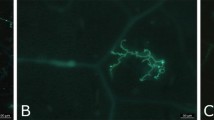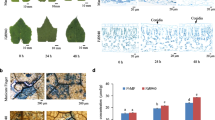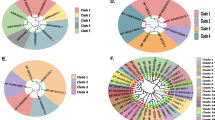Abstract
Grape downy mildew (Plasmopara viticola) is one of the most destructive diseases of grapevine worldwide. In order to better understand the cellular processes involved in resistance to downy mildew, leaves of Vitis vinifera cv. ‘Centennial Seedless’ (susceptible) and Vitis labrusca×Vitis riparia cv. ‘Beta’ (resistant) were inoculated with Plasmopara viticola, and were used in the Illumina HiSeq™2000 platform for deep transcriptome sequencing. We performed transcriptome analysis and identified a total of 1091 differentially expressed genes (DEGs) in the disease-resistant cultivar and 849 in the susceptible cultivar. To increase understanding of the DEGs, the datasets were analyzed using Gene Ontology (GO) and the Kyoto Encyclopedia of Genes and Genome (KEGG) database. Most of them were found to be associated with plant–pathogen interaction, flavonoid synthesis, phenylpropanoid synthesis metabolism and phytohormone signal transduction. Moreover, transcription factors ERF, MYB, WRKY, and bHLH associated with disease resistance were screened. A total of 196 genes were identified as the candidate resistant genes. The expression of 18 differentially expressed genes was detected by RT-qPCR. Finally, the pattern of differentially expressed genes was consistent with the result of transcriptome sequencing. The present study identified several candidate resistance genes and signal transduction pathways that may contribute to downy mildew resistance in grapes.







Similar content being viewed by others
References
Allègre M, Héloir MC, Trouvelot S, Daire X, Pugin A, Wendehenne D, Adrian M (2009) Are grapevine stomata involved in the elicitor-induced protection against downy mildew? Mol Plant-Microbe Interact 22:977–986
Altschul SF, Madden TL, Schaffer AA, Zhang JH, Zhang Z, Miller W, Lipman DJ (1997) Gapped BLAST and PSI-BLAST: a new generation of protein database search programs. Nucleic Acids Res 25:3389–3402
Ammar A., Elouedi Z., Lingras P (2012) RPKM: the rough possibilistic K-modes. Foundations of intelligent systems: 20th international symposium 81–86
Ashburner M, Ball CA, Blake JA et al (2000) Gene ontology: tool for the unification of biology. Gene 25(1):25–29
Bellin D, Peressotti E, Merdinoglu D et al (2009) Resistance to Plasmopara viticola in grapevine 'Bianca' is controlled by a major dominant gene causing localised necrosis at the infection site. Theor Appl Genet 120:163–176
Bisson L, Waterhouse A, Ebeler S, Walker M, Lapsley J (2002) The present and future of the international wine industry. Nature 418:696–699
Busam G, Kassemeyer HH, Matern U (1997) Differential expression of chitinases in Vitis vinifera L. responding to systemic acquired resistance activators or fungal challenge. Plant Physiol 115:1029–1038
Cadle-Davidson L (2008) Variation within and between Vitis spp. for foliar resistance to the downy mildew pathogen Plasmopara viticola. Plant Dis 92:1577–1584
Conesa A, Gotz S, Garcia-Gomez JM, Terol J, Talon M, Robles M (2005) Blast2GO: a universal tool for annotation, visualization and analysis in functional genomics research. Bioinformatics 21:3674–3676
Dick MW (2002) Binomials in the Peronosporales, Sclerosporales and Phytiales. In: Spencer-Phillips PTN, Gisi U, Lebeda A (eds) Advances in downy mildew research. Kluwer Academic Publishers, Dordrecht, pp 225–265
Diez-Navajas AM, Wiedemann-Merdinoglu S, Greif C, Merdinoglu D (2008) Nonhost versus host resistance to the grapevine downy mildew, Plasmopara viticola, studied at the tissue level. Phytopathology 98:776–780
Doster M, Schnathorst W (1985) Effects of leaf maturity and cultivar resistance on development of the powdery mildew fungus on grapevines. Phytopathology 75:318–321
Dubos B (2002) Maladies cryptogamiques de la vigne. Féretedn, Bordeaux
Eddy SR (2011) Accelerated profile HMM searches. PLoS Comput Biol 7(10):e1002195
Dubreuil-Maurizi C, Trouvelot S, Frettinger P, Pugin A, Wendehenne D, Poinssot B (2010) β-Aminobutyric acid primes an NADPH oxidase-dependent reactive oxygen species production during grapevine-triggered immunity. Mol Plant-Microbe Interact 23:1012–1021
Feechan A, Anderson C, Torregrosa L, Jermakow A, Mestre P, Wiedemann-Merdinoglu S, Merdinoglu D, Walker AR, Cadle-Davidson L, Reisch B, Aubourg S, Bentahar N, Shrestha B, Bouquet A, Adam-Blondon AF, Thomas MR, Dry IB (2013) Genetic dissection of a TIR-NB-LRR locus from the wild north American grapevine species Muscadinia rotundifolia identifies paralogous genes conferring resistance to major fungal and oomycete pathogens in cultivated grapevine. Plant J 76(4):661–674
Fekete C, Fung RW, Szabo Z, Qiu W, Chang L, Schachtman DP, Kovacs LG (2009) Up-regulated transcripts in a compatible powdery mildew-grapevine interaction. Plant Physiol Biochem 47(8):732–738
Figueiredo A, Fortes AM, Ferreira S, Sebastiana M, Choi YH, Sousa L, Acioli-Santos B, Pessoa F, Verpoorte R, Pais MS (2008) Transcriptional and metabolic profiling of grape (Vitis vinifera L.) leaves unravel possible innate resistance against pathogenic fungi. J Exp Bot 59:3371–3381
Fischer B.M., Salakhutdinov I., Akkurt M., Eibach R., Edwards K.J, Topfer R., Zyprian E.M (2004) Quantitative trait locus analysis of fungal disease resistance factors on a molecular map of grapevine. Theor Appl Genet 108:501–515
Fröbel S, Dudenhöffer J, Töpfer R, Zyprian E (2019) Transcriptome analysis of early downy mildew (Plasmopara viticola) defense in grapevines carrying the Asian resistance locus Rpv10. Euphytica 215:28
Fung RWM, Qiu WP, Su YC, Schachtman DP, Huppert K, Fekete C, Kovacs LG (2007) Gene expression variation in grapevine species Vitis vinifera L. and Vitis aestivalis Michx. Genet Resour Crop Evol 54:1541–1553
Gessler C, Pertot I, Perazzolli M (2011) Plasmopara viticola, the causal agent of downy mildew of grapes. Phytopathol Mediterr 50:3–44
Godard S, Slacanin I, Viret O, Gindro K (2009) Induction of defence mechanisms in grapevine leaves by emodin and anthraquinone-rich plant extracts and their conferred resistance to downy mildew. Plant Physiol Biochem 47:827–837
Hamiduzzaman MM, Jakab G, Barnavon L, Neuhaus JM, Mauch-Mani B (2005) ß-Aminobutyric acidinduced resistance against downy mildew in grapevine acts through the potentiation of callose formation and jasmonic acid signaling. Mol Plant-Microbe Interact 18:819–829
Han YQ, Zhang K, Yang J, Zhang N, Fang A, Zhang Y, Liu YF, Chen ZY, Hsiang T, Sun WX (2015) Differential expression profiling of the early response to Ustilaginoidea virens, between false smut resistant and susceptible rice varieties. BMC Genomics 16(1):955
Harm A, Kassemeyer HH, Seibicke T, Regner F (2011) Evaluation of chemical and natural resistance inducers against downy mildew (Plasmopara viticola) in grapevine. Am J Enol Vitic. https://doi.org/10.5344/ajev.2011.09054
Jaillon O, Aury JM, Noel B et al (2007) The grapevine genome sequence suggests ancestral hexaploidization in major angiosperm phyla. Nature 449:463–467
Jürges G, Kassemeyer HH, Dürrenberger M, Düggelin M, Nick P (2009) The mode of interaction between Vitis and Plasmopara viticola Berk. & Curt. Ex de Bary depends on the host species. Plant Biol 11:886–898
Kortekamp A (2006) Expression analysis of defence-related genes in grapevine leaves after inoculation with a host and a non-host pathogen. Plant Physiol Biochem 44:58–67
Kortekamp A, Zyprian E (2003) Characterization of Plasmopara-resistance in grapevine using in vitro plants. J Plant Physiol 160:1393–1400
Langmead B., Salzberg S.L (2012) Fast gapped-read alignment with bowtie 2, nature methods 9(4): 357–359
Liang C, Liu L, Zang C, Zhao K, Liu C (2015) Characterization and induction kinetics of a putative candidate gene associated with downy mildew resistance in grapevine. Eur J Hortic Sci 80(5):216–224
Livak KJ, Schmittgen TD (2001) Analysis of relative gene expression data using real-time quantitative PCR and the 2-△△CT method. Methods 25:402–408
Malacarne G, Vrhovsek U, Zulini L, Cestaro A, Stefanini M, Mattivi F, Delledonne M, Velasco R, Moser C (2011) Resistance to Plasmopara viticola in a grapevine segregating population is associated with stilbenoid accumulation and with specific host transcriptional responses. BMC Plant Biol 11:114
Marchive C, Mzid R, Deluc L, Barrieu F, Pirrello J, Gauthier A, Corio-Costet MF, Regad F, Cailleteau B, Hamdi S, Lauvergeat V (2007) Isolation and characterization of a Vitis vinifera transcription factor, VvWRKY1, and its effect on responses to fungal pathogens in transgenic tobacco plants. J Exp Bot 58(8):1999–2010
Merdinoglu D, Wiedemann-Merdinoglu S, Coste P, Dumas V, Haetty S, Butterlin G, Greif C (2003) Genetic analysis of downy mildew resistance derived from Muscadinia rotundifolia. Acta Hortic 603:451–456
Minoru K, Susumu G, Shuichi K, Yasushi O, Masahiro H (2004) The KEGG resource for deciphering the genome. Nucleic Acids Res 1(32):D277–D280
Monteiro F, Sebastiana M, Pais MS, Figueiredo A (2013) Reference gene selection and validation for the early responses to downy mildew infection in susceptible and resistant Vitis vinifera cultivars. PLoS One 8(9):e72998
Mortazavi A, Williams BA, McCue K, Schaeffer L, Wold B (2008) Map** and quantifying mammalian transcriptomes by RNA-Seq. Nat Methods 5:621–628
Nascimento R, Maia M, Ferreira AEN, Silva AB, Freire AP, Cordeiro C, Silva MS, Figueiredo A (2019) Early stage metabolic events associated with the establishment of Vitis vinifera - Plasmopara viticola compatible interaction. Plant Physiol Biochem 137:1–13
Perazzolli M., B. Roatti, E. Bozza and I. Pertot (2011) Trichoderma harzianum T39 induces resistance against downy mildew by priming for defence without costs for grapevine. Biological Control. https://doi.org/10.1016/j.biocontrol.2011.04.006
Polesani M, Bortesi L, Ferrarini A, Zamboni A, Fasoli M, Zadra C et al (2010) General and species-specific transcriptional responses to downy mildew infection in a susceptible (Vitis vinifera) and a resistant (V. riparia) grapevine species. BMC Genomics 11:117
Powell S., Szklarczyk D., Trachana K., Roth A., Kuhn M., Muller J., Arnold R., Rattei T., Letunic I., Doerks T., Jensen L.J., von Mering C., Bork P (2011) eggNOG v3.0:orthologous groups covering 1133 organisms at 41 different taxonomic ranges. Nucleic acids res. Epub Nov 16; PubMed 22096231
Radakovits R, **kerson RE, Fuerstenberg SI, Tae H, Settlage RE, Boore JL, Posewitz MC (2012) Draft genome sequence and genetic transformation of the oleaginous alga: Nannochloropsisgaditana. Nat Commun 3:686
Seehalak W, Moonsom S, Metheenukul P, Tantasawat P (2011) Isolation of resistance gene analogs from grapevine resistant and susceptible to downy mildew and anthracnose. Sci Hortic 128:357–363
Sha YX, Wang GZ, Fan ZQ (2011) Effect of different humidity time on occurrence of Plasmopara viticola in grape. Acta Agriculturae Boreali-occidentalis Sinica 20(10):196–200
Stec N, Banasiak J, Jasiński M (2016) Abscisic acid-an overlooked player in plant-microbe symbioses formation? Acta Biochimica Polonica 63(1):53–58
Trouvelot S, Varnier AL, Allegre M, Mercier L, Baillieul F, Arnould C, Gianinazzi-Pearson V, Klarzynski O, Joubert JM, Pugin A, Daire X (2008) A beta-1,3 glucan sulfate induces resistance in grapevine against Plasmopara viticola through priming of defense responses, including HR-like cell death. Mol Plant-Microbe Interact 21:232–243
Wang L, Feng Z, Wang X, Wang X, Zhang X (2009) DEGseq: an R package for identifying differentially expressed genes from RNA-seq data. Bioinformatics 26(1):136–138
Wang C, Wu J, Zhang Y, Lu J (2018) Muscadinia rotundifolia ‘Noble’ defense response to Plasmopara viticola inoculation by inducing phytohormone-mediated stilbene accumulation. Protoplasma 255:95–107
Welter LJ, Gokturk-Baydar N, Akkurt M, Maul E, Eibach R, Topfer R, Zyprian OEM (2007) Genetic map** and localization of quantitative trait loci affecting fungal disease resistance and leaf morphology in grapevine (Vitis vinifera L). Mol Breed 20:359–374
Wu J, Zhang Y, Zhang H, Huang H, Folta KM, Lu J (2010) Whole genome wide expression profiles of Vitis amurensis grape responding to downy mildew by using Solexa sequencing technology. BMC Plant Biol 10(1):234–250
Yu Y, Zhang Y, Yin L, Lu J (2012) The mode of host resistance to Plasmopara viticola infection of grapevines. Phytopathology 102:1094–1101
Yuan Z, Zhang Y, Xu G, Bi D, Ha Q, Zou X, Gao X, Yang H, He H, Wang X, Bao J, Zuo S, Pan X, Zhou B, Wang G, Qu S (2018) Comparative transcriptome analysis of rhizoctonia solani resistant and susceptible rice cultivars reveals the importance of pathogen recognition and active immune responses in host resistance. Journal of Plant Biology 61(3):143–158
Zhang JJ, Yue** W, **** W, Keqiang Y, **xiao Y (2003) An improved method for rapidly extracting total RNA from Vitis. Journal of Fruit Science 20(3):178–181
Acknowledgments
For the technical assistance during the data analysis, we would like to thank Bioeditas Technology Corporation (Shanxi, China).
This study was funded by Special Fund for AgroScientific Research in the Public Interest of the People’s Republic of China (201203035), and the Funded Projects for Science and Technology Development Plan of Liaoning (No. 2018103003).
Author information
Authors and Affiliations
Corresponding author
Ethics declarations
Conflict of interest
The authors declare that the research was conducted in the absence of any commercial or financial relationships that could be construed as a potential conflict of interest.
Additional information
Publisher’s note
Springer Nature remains neutral with regard to jurisdictional claims in published maps and institutional affiliations.
Rights and permissions
About this article
Cite this article
Liu, L., Zhang, B., Wang, H. et al. Candidate resistance genes selection and transcriptome analysis for the early responses to Plasmopara viticola infection in grape cultivars. J Plant Pathol 102, 857–869 (2020). https://doi.org/10.1007/s42161-020-00546-x
Received:
Accepted:
Published:
Issue Date:
DOI: https://doi.org/10.1007/s42161-020-00546-x




